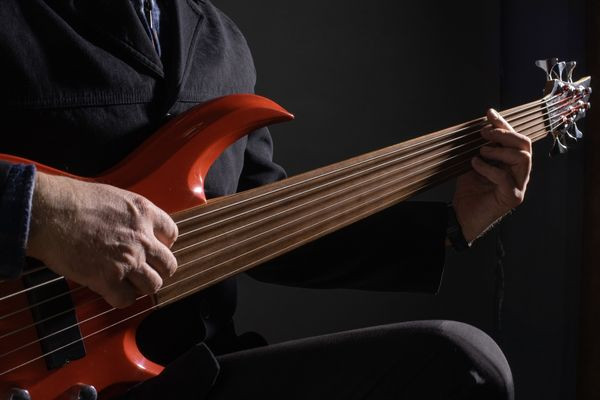The electric bass guitar, stemming from its upright ancestor, initially mirrored its string configuration, range, and intervals but offered enhanced portability for genres like jazz and rock. However, the bass guitar’s role quickly transcended mere rhythm accompaniment. Innovations, notably the emergence of five and six-string models, alongside instruments like the Bass VI, broadened its sonic palette and playing possibilities.
For those beginning their bass journey, the four-string variant is often recommended to establish fundamental techniques. Yet, as your proficiency grows, transitioning to a six-string bass guitar opens up new musical horizons. Let’s delve into what defines a six-string bass and how it enriches your playing experience.
 musician playing six-string bass guitar
musician playing six-string bass guitar
Unpacking the Six-String Bass Guitar
The defining characteristic of a six-string bass guitar is the addition of two extra strings. These are typically a low B string, which extends the instrument’s lower range, and a high C string, expanding its upper register. This expanded range diminishes the need to traverse the fretboard extensively to reach specific notes and significantly alters the instrument’s melodic capabilities. This configuration fosters smoother transitions and facilitates chord playing with greater ease.
The popularity of the six-string bass surged in the 1970s and 1980s, coinciding with the increasing prominence of keyboards in rock and New Wave music, which often absorbed traditional rhythm roles. Today, bassists aiming for a more melodic presence and venturing into solo performances frequently gravitate towards the six-string bass guitar.
It’s crucial to distinguish the six-string bass guitar from the Bass VI. While both have six strings, the Bass VI is tuned identically to a standard guitar but an octave lower. Similarly, the Bass VI differs from a baritone guitar, which is a standard guitar tuned to a lower range but not as low as a bass.
Technique Adaptation for Six-String Bass
The most immediate difference for players transitioning to a six-string bass guitar is the narrower string spacing on a wider, thicker neck. Initially, players may find it challenging to navigate this tighter space and maintain precise sound control. Accidental muting or unintended string contact can be common at first.
However, once these initial hurdles are overcome, the six-string bass guitar facilitates more fluid melodic playing. The string spacing becomes advantageous for chord voicings and enhances clarity when playing polyphonic passages. It’s advisable to experiment with various six-string bass guitars to find a neck profile and string spacing that suits your playing style and hand comfort.
Expanded Range: Sonic Advantages of Six Strings
The extended range offered by the two additional strings unlocks several musical possibilities:
- Enhanced Chord Voicing: The low B and high C strings enable bassists to create richer, more resonant chord voicings by spacing notes across a wider spectrum.
- Accessing Lower Frequencies: For music requiring deeper bass frequencies, the low B string eliminates the need to down-tune a four-string bass, offering immediate access to lower notes while retaining the higher range.
- Melodic Versatility: While four-string basses excel in rhythmic and groove-oriented styles, the six-string bass guitar empowers bassists to explore more melodic territories. The additional C string allows for brighter melodic lines and reduces the need for extensive fretboard shifts when playing in higher registers, enabling bassists to craft compelling melodic passages with a richer, deeper tone than a guitar.
Chordal Possibilities on a Six-String Bass
While chord playing is possible on a four-string bass, the resulting voicings can sometimes sound constricted within the lower frequency range. The expanded range of the six-string bass guitar, incorporating the low B and high C strings, provides greater definition and resonance for chordal work.
It’s important to note that the six-string bass guitar is not intended to mimic a guitar. Instead, it bridges rhythmic and melodic roles, offering a unique space within the musical spectrum. In contrast, the Bass VI is designed to function more like a traditional guitar in a lower register.
Ready to explore the expanded world of bass playing? Discover a range of electric bass guitars at DuBaldo Music Center and consider enriching your skills with bass lessons. Contact us today to learn more and embark on your six-string bass guitar journey.
